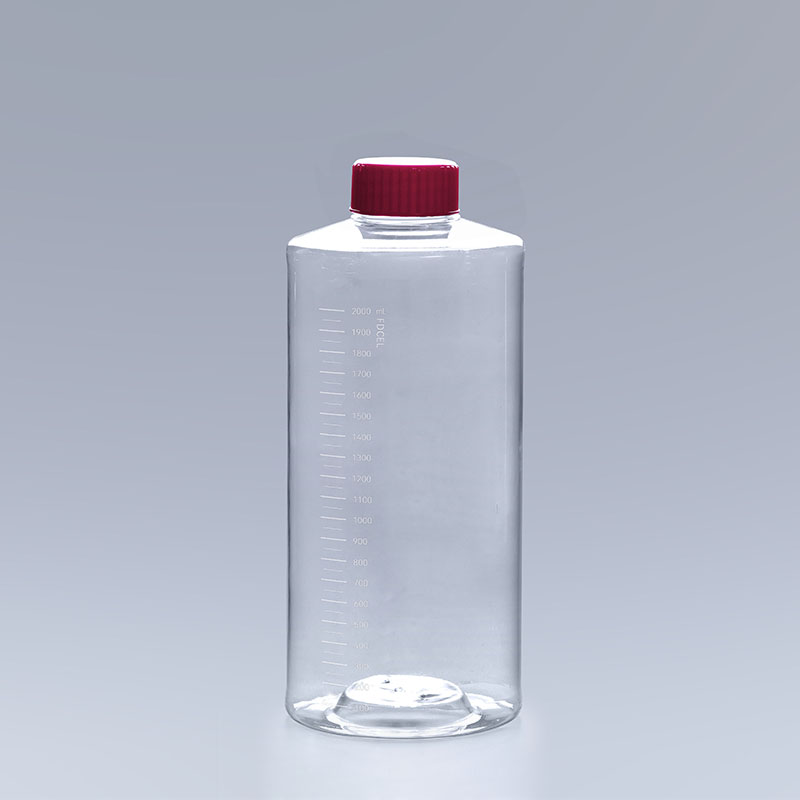Cell Roller Bottles are an important tool in modern life science research and biopharmaceutical industry.
It plays an indispensable role in both cellular research in the laboratory and large-scale biologics production, promoting all stages of development from basic research to industrialized production.
Design and Features of Cell Roller Bottles
Cell Roller Bottles are usually made of transparent plastic material with good physicochemical properties to ensure the visualization of cell culture and the smooth running of the culture process.
1. Volume and size
The capacity of Cell Roller Bottles usually ranges from 25 ml to 250 ml, depending on the scale of the experiment and the needs of cell culture.For high-density cell culture, large capacity Cell Roller Bottles (e.g. 250 ml) are commonly used for large-scale biologics production such as virus or vaccine production.
2. Material and design
Cell Roller Bottles are mostly made of single-use materials to avoid the risk of contamination. The bottles are transparent, so that the growth of cells can be easily observed.The bottom of the bottle is usually flat or specially treated with a walled area to support cell attachment and provide space for growth.
3. Aseptic performance
Aseptic performance is one of the core features of Cell Roller Bottles.Cell Roller Bottles are rigorously sterilized during the manufacturing process and packaged in a way that ensures complete sealing to prevent any source of contamination from entering.
Sterility ensures a pure environment for cell culture, thus reducing the risk of contamination and guaranteeing reliable results.

Application Areas of Cell Roller Bottles
Cell Roller Bottles have a wide range of applications in the life science and biopharmaceutical fields, covering a number of research and production areas.
1. Cell biology research
In cell biology research, Cell Roller Bottles are widely used for cell culture, differentiation, proliferation and observation. By using Cell Roller Bottles to culture different types of cells, researchers explore the basic biological processes of cells, such as growth, apoptosis, and stress response. Cell Roller Bottles provide a stable environment for the cells, allowing experiments to run smoothly under highly controlled conditions.
2. Virology and Microbiology Research
In virology and microbiology research, Cell Roller Bottles are a key tool for the cultivation of microorganisms such as viruses and bacteria. For example, Cell Roller Bottles are often required to culture specific types of cells (e.g., Vero cells, HEK 293 cells) to amplify viruses during vaccine production. Cell Roller Bottles provide the necessary space and environment for viral expansion within the cells, ensuring that the viral population is increased to provide the raw material for vaccine production.
3. Biopharmaceutical and vaccine production
The application of Cell Roller Bottles in biopharmaceutical and vaccine production is crucial. In the case of rabies vaccines, for example, the virus usually needs to be cultured in Vero cells and produced by efficient replication of the virus in the cells. Cell Roller Bottles provide a controlled and stable growth environment, ensuring that the cells can be propagated under optimal conditions for efficient and quality mass production.
Strategies to prevent cell contamination
Cell contamination is the most common and problematic issue in cell culture. Contaminants may include bacteria, fungi, mycoplasma or viruses, etc., and they can seriously affect experimental results and even product quality. In order to effectively prevent contamination, the following are some important prevention and control strategies:
1. Strict aseptic operation
Aseptic operation is the most basic requirement to prevent cell contamination. Operators should strictly follow the aseptic operation specification, including hand cleaning, disinfection of the experimental area, and proper use of sterile tools. In addition, all equipment and reagents contacting cells should be strictly sterilized to avoid any source of contamination into the cell culture system.
2. High Quality Cell Roller Bottles and Consumables
High-quality Cell Roller Bottles are the basis for preventing contamination. Select qualified Cell Roller Bottles with good sealing and anti-contamination properties, which can effectively isolate the external source of contamination. The design of the cap and the durability of the material should also meet the standards to ensure smooth gas exchange during the culture process and no contamination by external microorganisms.
3. Regular testing and monitoring
In order to detect contamination problems in time, it is important to regularly check the clarity of the culture medium, the pH value, and the growth status of the cells. If abnormalities are detected, it is important to check for contamination. Some cell cultures can also be used for early detection of potential sources of contamination by PCR, microscopy and other methods.
In conclusion, Cell Roller Bottles are not only a basic tool in cell biology, virology and other research fields, but also an indispensable part of biologics production, vaccine production and other fields. By continuously optimizing the operation process, improving the conditions of cell culture and adopting high-quality Cell Roller Bottles, the success rate of experiments can be effectively improved, which can promote the rapid development of life science research and biopharmaceutical industry.
The FAI climbed 5.9 percent year-on-year in the first 11 months of 2018, quickening from the 5.7-percent growth in Jan-Oct, the National Bureau of Statistics (NBS) said Friday in an online statement.
The key indicator of investment, dubbed a major growth driver, hit the bottom in August and has since started to rebound steadily.
In the face of emerging economic challenges home and abroad, China has stepped up efforts to stabilize investment, in particular rolling out measures to motivate private investors and channel funds into infrastructure.
Friday's data showed private investment, accounting for more than 60 percent of the total FAI, expanded by a brisk 8.7 percent.
NBS spokesperson Mao Shengyong said funds into weak economic links registered rapid increases as investment in environmental protection and agriculture jumped 42 percent and 12.5 percent respectively, much faster than the average.
In breakdown, investment in high-tech and equipment manufacturing remained vigorous with 16.1-percent and 11.6-percent increases respectively in the first 11 months. Infrastructure investment gained 3.7 percent, staying flat. Investment in property development rose 9.7 percent, also unchanged.
 English
English


















































